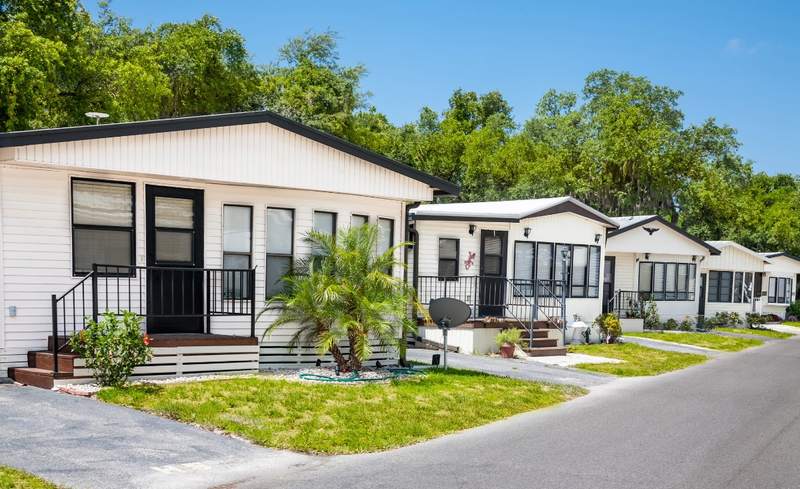Homeownership may feel like an unattainable dream, especially in today’s pricey real estate market. However, modular and manufactured homes can help keep this dream alive by providing a more affordable homebuying option.
Here’s a breakdown on modular homes versus manufactured homes, and how to determine which option is right for you.
Key Takeaways:
- Both modular homes and manufactured homes are built in a factory. However, modular homes are assembled at the home site, whereas manufactured homes are shipped fully assembled.
- Financing a modular home is like financing a traditional home in that the same loan options are available. Financing a manufactured home, on the other hand, requires a specialized loan program.
- Some of the differences between modular and manufactured homes are their durability, their value over time, and the building codes they must comply with.
What Is a Modular Home?
Modular homes are an affordable alternative to traditional houses, which are typically built on-site. Unlike site-built homes, modular homes are composed of different sections — or modules — that are prefabricated in a factory. These modules are then transported to your property and assembled by builders at the home site to create a complete house.
Making the modules in a factory means the builders have more control over the environment to ensure high-quality and efficient construction. The construction schedule isn’t subject to rain delays or daylight hours, and the materials aren’t exposed to the elements like they are with on-site builds.
Modular homes also can be customizable, and you’ll typically have the flexibility to choose features like the floor plan and the architectural style.
“[Modular homes] meet local building codes and can be indistinguishable from site-built homes, but they can be higher quality and more customizable,” says Bart Waldon, managing partner at Land Boss, a real estate investing company in El Dorado Hills, California.
How To Finance a Modular Home
Modular homes can be financed just like a traditional home — with a couple of additional loan options. Here are the types of mortgages available for financing a modular home:
- Construction loans are short-term loans with high interest rates that pay the contractor during the homebuilding phase. When construction is complete, you can either pay off the loan or convert it into a traditional mortgage. If you’re buying a modular home that’s already assembled, you don’t need a construction loan.
- Conventional loans are offered by private lenders. They typically require a credit score of 620 or higher, and a minimum down payment of 3%. Conventional lenders treat financing a modular home the same as financing a traditional home.
- Veterans Affairs loans, or VA loans, can be used by eligible service members, veterans, or their spouses to finance a modular home. One perk of using a VA loan to purchase a modular home is that it doesn’t require taking out a separate construction loan — the VA loan is all you’ll need.
- Department of Agriculture loans, or USDA loans, are designed for lower-income rural buyers. If you qualify, and the modular home you’re buying is in a designated rural area, a USDA loan could be an option for financing.
- Federal Housing Administration loans, or FHA loans, can be a way for qualified borrowers to purchase a modular home. These loans have lower down payment and credit score requirements.
- Personal loans are unsecured loans that can be used for any purpose — including buying a modular home. But the maximum loan amount is usually too small, so they generally can’t be used to completely finance a traditional home purchase. Personal loans also come with high interest rates and short repayment terms.
Pros and Cons of Modular Homes
Is a modular home right for you? Here are some pros and cons of modular homes to help you make that decision.
Benefits of modular homes
Modular homes offer many advantages that make them an attractive option for homeownership, including:
- Cost-effective option for homebuying. The national average cost of a modular home in 2022 is $270,000, but some modular homes can be bought for as little as $180,000. Compare that to $552,600, which is the average sales price of all homes sold in the fourth quarter of 2022.
- Durability. Modular homes use extra screws, framing, and adhesive to withstand the stressors of transportation and assembly. They also aren’t exposed to weather and moisture during the construction of the modules, which means they can be more durable than traditional homes.
- Smaller environmental impact. Efficient construction practices mean fewer raw materials are used. The modular home industry also mandates certain environmentally friendly building practices, such as insulation standards, which saves energy and money. What’s more, homebuyers have a variety of energy-saving features to choose from, such as optimized heating, ventilating, and air conditioning systems, or smart-home technology.
- Eligible for traditional financing. Mortgage lenders typically treat mortgages for modular homes and traditional homes the same.
- Appreciating home value. A modular home typically appreciates in value similarly to a traditional home, creating a long-term investment and helping you build equity.
- Adherence to the same building codes as traditional homes. Modular homes must meet the same building codes as site-built homes. This requirement ensures that modular homes follow safety and quality standards.
Drawbacks of modular homes
All home types have both pros and cons. Drawbacks for modular homes include:
- Buyers must find land. Securing a suitable plot of land is one of the first steps in building a modular home. This can be a time-consuming process, and the cost and availability of land varies depending on the location.
- Modular homes tend to be smaller. This isn’t always the case, but if you’re shopping for a modular home, expect to tour some smaller homes. There are larger options out there, but if you’re looking for serious square footage, then you might have to do more digging — or design a custom modular home.
- Lingering poor reputation. While the public perception of modular homes is changing, in the past, modular homes were viewed as cheap and of lower quality.
- It can be difficult to make changes once plans are finalized. Because the home is prebuilt in a factory, there’s little room for last-minute adjustments.
- You’ll need to build a foundation, which can be expensive. Modular homes require a foundation to sit on, which can cost tens of thousands of dollars.
- Lack of portability. Modular homes are not designed for mobility. Once installed, they are difficult to relocate.
What Is a Manufactured Home?
Manufactured homes — formerly known as mobile homes — are an affordable housing option. Like modular homes, manufactured homes are prefabricated in a factory and transported to their final location. They are built on a steel chassis with wheels, making them easy to move. Once at their destination, they’re often placed on a permanent foundation.
Manufactured homes are available in several sizes, layouts, and styles, so it’s possible to find an option that works for your preferences and lifestyle. They offer flexibility by being easily expandable with additional manufactured modules.
“Manufactured homes tend to work better as primary residences or vacation homes, rather than as rental investments,” Waldon says.
How To Finance a Manufactured Home
A manufactured home is trickier to finance than a traditional home or a modular home. In fact, a 2022 Pew survey found that lenders denied 54% of people who wanted to buy manufactured homes, whereas lenders only denied 7% of people who wanted to buy traditional site-built homes.
Unlike traditional homes, manufactured homes tend to depreciate in value over time, and they are often considered personal property instead of real property. The distinction between the two is that real property includes land and the buildings fixed to it, while personal property is any property besides real estate.
Here are the available loan options for manufactured homes:
- FHA Title I loans are designed specifically for purchasing or refinancing manufactured homes. These loans don’t require you to own the lot on which your manufactured home will sit. Instead, you can lease a spot in a manufactured home community or elsewhere. The maximum repayment term is 20 years.
- FHA Title II loans are available for all types of single-family properties, including manufactured homes. They offer traditional 15-year and 30-year terms.
- Fannie Mae MH Advantage loans finance manufactured homes that meet specific design and construction standards, such as energy efficiency. Qualified borrowers can secure conventional financing for eligible homes with as little as 3% down.
- Freddie Mac Home Possible loans require a minimum 5% down payment to purchase a manufactured home. Like MH Advantage by Fannie Mae, Freddie Mac’s program helps first-time homebuyers secure a low-interest loan.
- VA loans can be used by eligible borrowers to purchase a manufactured home.
- Chattel loans are specifically designed to finance manufactured homes. They’re secured by the home itself, but not the land. Chattel mortgages have higher interest rates, but also offer lower qualification requirements.
- Personal loans are unsecured and may have dramatically higher interest rates, but they can be suitable when your financing options are limited.
Pros and Cons of Manufactured Homes
Here are some pros and cons of manufactured homes.
Benefits of Manufactured Homes
Reasons why buyers might consider a manufactured home include:
- Budget-friendly. The average sales price of a new manufactured home in April 2023 was $125,200.
- Stringent safety standards ensure durability and safety. Since 1976, manufactured homes have adhered to the safety and construction standards set by the Department of Housing and Urban Development. This means that modern manufactured homes are much more durable than the mobile homes of the past.
- Potential for portability. Though many homeowners will never move their manufactured homes, they are technically considered a vehicle and can be moved by professionals if needed, thanks to the steel chassis with wheels that they’re sometimes fixed to.
- Efficient construction. Like modular homes, manufactured homes are built in a controlled factory environment. This reduces construction timelines and labor costs, and can result in fewer weather-related delays.
- Faster moving timeline. Efficient construction lets buyers move into their manufactured homes quicker than with site-built homes.
- Customizable. Many manufactured homes offer plenty of opportunities for customization, allowing buyers to create a home that suits their preferences and needs.
Drawbacks of Manufactured Homes
Just like any type of home, manufactured homes have drawbacks, too.
“The cons [of manufactured homes] are that they can depreciate in value faster and have more zoning restrictions,” Waldon says. “Buyers should do research to understand any zoning restrictions in the area you are purchasing in.”
Here are the main things to consider before purchasing a manufactured home:
- Slower appreciation. Manufactured homes don’t appreciate in value as much as site-built homes or modular homes, which affects their long-term investment potential.
- Land leases often required. Many times, homeowners must lease the land for their manufactured homes. These lease agreements can vary, and buyers should be clear on the terms and costs involved.
- Community fees. In addition to leasing the land, owners of manufactured homes may need to pay monthly fees for amenities and maintenance if they live in a manufactured home community.
- Often ineligible for traditional mortgages. While there are several financing options for manufactured homes, obtaining a mortgage can be difficult or even impossible. Specialized loans for manufactured homes often have different requirements and eligibility criteria.
- Smaller floor plans than traditional homes. Most builders of manufactured homes have standardized sizes and layouts, which means your living space generally will be smaller.
Manufactured vs. Modular Homes
Here’s a summary of the key differences between manufactured and modular homes:
Differences Between Modular and Manufactured Homes
| Modular Homes | Manufactured Homes | |
| Cost To Build | $80 to $160 per square foot. | $55 per square foot. |
| Time To Build | 16 to 31 weeks. | 16 weeks. |
| Build Method | Built in a factory and assembled at the home site. | Built in a factory and shipped fully assembled; often fixed to a steel chassis at the home site. |
| Durability | Built to withstand transportation and assembly. | Less durable compared to modular or traditional homes. |
| Value Over Time | Typically appreciates. | Typically depreciates. |
| Financing Options | Can be financed with traditional loans. | Conventional financing is difficult to get; often requires a specialized loan program. |
| Mobility | Not mobile once constructed on-site. | While some manufactured homes have a foundation, they can be mobile if needed. |
| Building Code | Must adhere to the same building codes as traditional homes. | Must comply with federal building standards. |
| Customizability | Can be customizable. | Some customization options, but are typically limited. |
| Foundation Type | Placed on a permanent foundation. | Can be placed on a permanent foundation, but often on piers, blocks, or a steel chassis. |
| Real or Personal Property | Considered real property. | Unless it has a permanent foundation, it’s considered personal property. |
| Taxes | Treated as real property and subject to property taxes. | Sales tax or use tax if the home isn’t fixed to a foundation and is considered personal property; property taxes if the home is fixed to a foundation and considered real property. |
Alternatives to Modular or Manufactured Homes
If modular or manufactured homes don’t sound right for you, consider these alternative options:
- Single-family homes are stand-alone structures built on their own lot, offering privacy and lots of opportunities for personalization. They are ideal for families or individuals who want a yard or private space.
- Townhouses are typically multilevel residences sharing at least one wall with a neighboring unit. They offer both privacy and a community living experience.
- Condominiums are individual units in a larger building or complex. Like townhomes, condos offer shared amenities and costs, and they’re great for people looking for lower-maintenance living.
- Tiny homes are small, compact homes that are designed for cost-effective, eco-friendly living. They’re perfect for minimalists and anyone looking to seriously downsize.
- Brownstones are multistory houses that are common in older city neighborhoods, and often share walls with their neighbors. People who appreciate historic charm and want to live in an urban setting may enjoy a brownstone.
- Patio homes are typically single-story homes with small backyards that are connected to other patio homes.
How To Decide Between Modular and Manufactured Homes
Both manufactured and modular homes offer advantages and disadvantages. Here’s how to choose which type of home is the best fit for you.
Modular homes may be right for you if:
- You want to customize your home.
- You value durability.
- You’re looking for a permanent residence.
- You want traditional financing.
Manufactured homes may be right for you if:
- You’re prioritizing affordability.
- You want to stay mobile.
- You’re in a hurry to move in.
“The type of home I recommend really depends on the client’s goals,” Waldon says. “The most important thing is making sure the home fits the lifestyle and goals of the individual buyer. There is no one-size-fits-all solution. Focusing on the client’s needs helps guide them to the right home type for their situation.”
FAQ: Modular vs. Manufactured Homes
Here are answers to some common questions about manufactured and modular homes.
Manufactured homes and mobile homes are terms that are often used interchangeably. While both are similar in design and mobility, the terminology indicates different eras and construction standards. Manufactured homes comply with strict federal regulations, while mobile homes were built before 1976 and followed less rigorous regulations.
On-frame modular homes are transported to the home site with the steel frame still attached, and then installed on the foundation. Off-frame modular homes have no steel chassis underneath, and resemble traditional homes more closely.
Yes, you can rent both modular and manufactured homes, although the rental market is dependent on your location. Manufactured homes are often located in manufactured home communities, and you may lease from the owner or from a property management company. Modular homes are less frequently available for rent.
The Bottom Line on Modular vs. Manufactured Homes
Choosing between a modular home and a manufactured home comes down to your preferences, needs, and goals. Whether you’re drawn to the customizability of modular homes, or the affordability of manufactured homes, both options can help you achieve your dreams of homeownership.
- Angi (2022)
- Federal Reserve Bank of St. Louis (2022)
- The Pew Charitable Trusts (2022)
- U.S. Census Bureau (2023)






